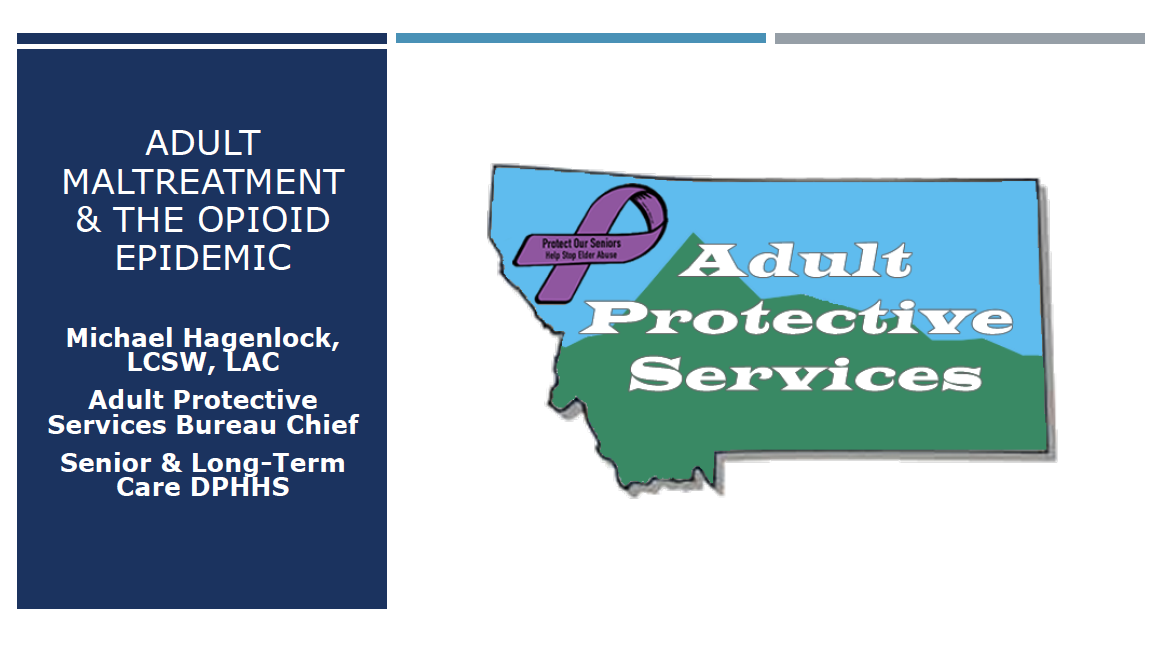Keeping_Adults_Safe_Session_One
Michael Hagenlock, LCSW, LAC
Adult Protective Services Bureau Chief
Senior & Long-Term Care DPHHS
View, print or download the PowerPoint presentation
Learning Objectives
- Define Adult Maltreatment
- Understand why At-Risk adults are targets for adult maltreatment
- Understand the link between Financial Exploitation and Abuse & Neglect
- How adult maltreatment affects the health and safety of adults
- How Opioids epidemic affects the older adults
Adult Protective Services (APS) of Montana
- APS is a bureau within Senior and Long Term-Care (SLTC); a Division of the Montana Department of Public Health and Human Services (DPHHS)
- APS has a duty to investigate all allegations of Abuse, Sexual Abuse, Neglect or Exploitation involving at-risk adults age 18 and older
- APS is a civil investigation unit – not a criminal investigation unit
What Is Adult Maltreatment?
- Physical, emotional, and sexual abuse
- Financial exploitation
- Neglect
- Self-Neglect
- Includes Self- Neglect
Person Centered Response to Adult Maltreatment
Understanding Adult Maltreatment
- Abuse
- Neglect
- Exploitation
- Self-Neglect
- Many times adults can and do experience more than one type of Abuse, Neglect or Exploitation
Types of Adult Maltreatment
- Abuse:
- Medical Abuse, Physical Abuse, Psychological Abuse, Sexual Abuse
- Neglect:
- Financial Neglect, Medical Neglect, Physical Neglect, Psychological Neglect, Self Neglect
- Exploitation:
- Financial and Property
Abuse
Any knowing or intentional act on the part of a caregiver or any other person which results the infliction of physical or mental injury; or the deprivation of food, shelter, clothing, or services necessary to maintain the physical or mental health of an older person or a person with a disability without lawful authority, sexual abuse, or sexual exploitation of a vulnerable adult
Neglect
The failure of a person who has assumed legal responsibility or a contractual obligation for caring for vulnerable adult or who has voluntarily assumed responsibility for the person's care, including an employee of a public or private residential institution, facility, home, or agency, to provide food, shelter, clothing, or services necessary to maintain the physical or mental health of a vulnerable adult to such an extent that there is actual physical injury to a vulnerable adult or imminent danger of the vulnerable adult suffering physical injury or death.
Exploitation
The unreasonable use of an older person or an adult person with a disability power of attorney, conservatorship, or guardianship in order to obtain control of or to divert to the advantage of another the ownership, use, benefit, or possession of or interest in the person's money, assets, or property by means of deception, duress, menace, fraud, undue influence, or intimidation with the intent or result of permanently depriving the older person or person with a disability of the ownership, use, benefit, or possession of or interest in the person's money, assets, or property.
The Strangers
- In-person
- Door to door sales
- Car sales
- Charity solicitations
- Targeted robbery/burglary
- Street cons
- Phone
- Telemarketing
- Sweepstakes
- Email
- Scam Websites
- Social Media
- Imposters
- Grandchildren
- Government Officials
- Bank Employees
Why Are Person's Over Age 60 The Target?
- Have Established Assets
- Can be lonely and Isolated
- Unfamiliar with Financial matters
- Fear of reporting
- Have physical or other conditions that limit their abilities and are dependent on others for assistance
Consequences of Adult Maltreatment
- Psychological distress
- Decline in medical and mental health
- 2.9 Billion dollars lost annually
- 5.3 Billion dollars added to direct medical cost
- 300% higher risk of death for abused victims
Caregiver Stress
Caregiver stress is real. It can lead to physical and mental health problems. BUT....No amount of stress justifies abuse!
How Does Opioids Affect Our Older Population?
- Prescription opioids: can be used to treat moderate-to-severe pain and are often prescribed following surgery or injury, or for health conditions such as cancer. In recent years, there has been a dramatic increase in the acceptance and use of prescription opioids for the treatment of chronic, non-cancer pain, such as back pain or osteoarthritis, despite serious risks and the lack of evidence about their long-term effectiveness.
- Pharmaceutical fentanyl is a synthetic opioid pain reliever, approved for treating
severe pain, typically advanced cancer pain. It is 50 to 100 times more potent than
morphine. It is prescribed in the form of transdermal patches or lozenges and can
be diverted for misuse and abuse in the United States.
- However, most recent cases of fentanyl-related harm, overdose, and death in the U.S. are linked to illegally made fentanyl. It is sold through illegal drug markets for its heroin-like effect. It is often mixed with heroin and/or cocaine as a combination product—with or without the user’s knowledge—to increase its euphoric effects.
- Heroin use has increased sharply across the United States among men and women, most age groups, and all income levels. Some of the greatest increases occurred in demographic groups with historically low rates of heroin use, including women, people who are privately insured, and people with higher incomes.
Elder Abuse And The Opioid Epidemic
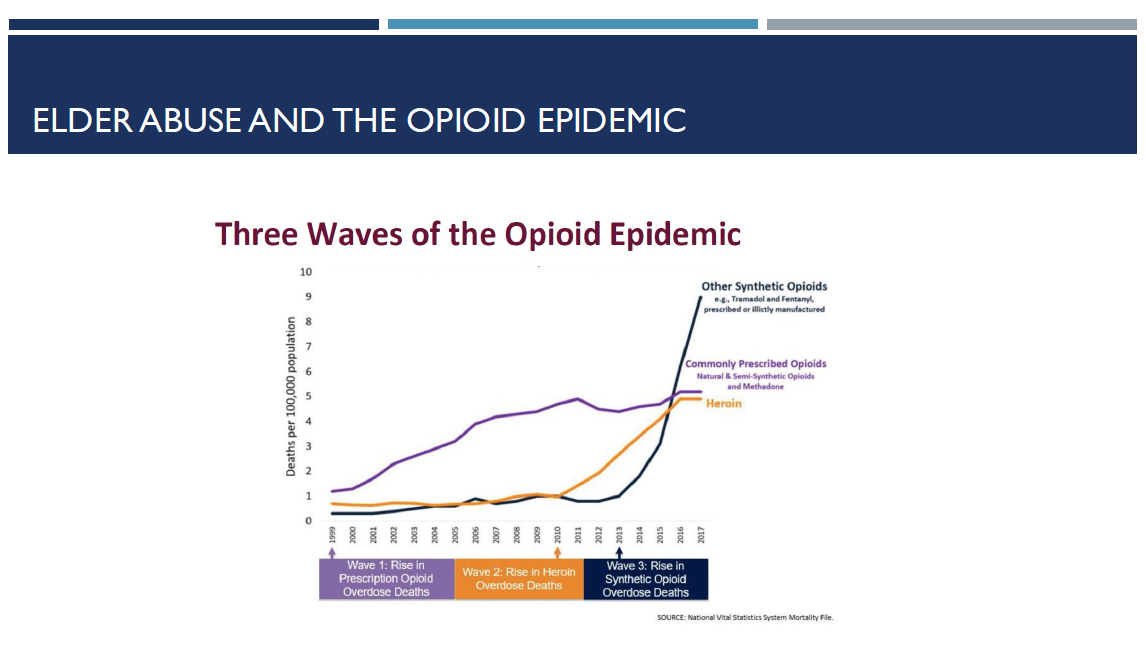
From 1999–2018, almost 450,000 people died from an overdose involving any opioid, including prescription and illicit opioids.
This rise in opioid overdose deaths can be outlined in three distinct waves.
- The first wave began with increased prescribing of opioids in the 1990s, with overdose deaths involving prescription opioids (natural and semi-synthetic opioids and methadone) increasing since at least 1999.3
- The second wave began in 2010, with rapid increases in overdose deaths involving heroin.
- The third wave began in 2013, with significant increases in overdose deaths involving synthetic opioids, particularly those involving illicitly manufactured fentanyl. The market for illicitly manufactured fentanyl continues to change, and it can be found in combination with heroin, counterfeit pills, and cocaine. Many opioid-involved overdose deaths also include other drugs.
Opioid Deaths
- American life expectancy declined for the 3rd consecutive year in 2017 driven by the increase in deaths from drug overdoses
- More than 1 out of 5 drug overdose deaths involved an opioid
- Every day, on average, 30 Americans die of a opioid overdose
- Opioid overdoses killed more than 47,600 people in 2017
Impacts of the Opioid Epidemic on Older Adults
- Health related issues
- neonatal abstinence syndrome, Hepatitis C, dental issues, mental health issues, malnourishment, accidents and suicide
- Family related issues
- parental absenteeism due to death or intoxication, incarceration, divorce, loss of parental custody, increase in grandparents raising grandchildren
- Mistreatment related issues
- domestic violence, theft, DUI, increased criminal related activity. inability to recruit workers who can pass drug screening tests, absenteeism, loss of productivity
Opioid Prescription: National Poll on Aging, University of Michigan, 2018.
The University of Michigan completed a poll in 2018 which indicated:
- Many older adults experience chronic pain
- 29% filled a prescription for opioid pain relievers in the past two years
- More than 50% report health providers counsel them about addiction, risk of overdose, or how to safely dispose of excess medication
- Approximately 86% of those prescribed opioids reported keeping leftover pills
Opioid Misuse By Older Adults Continued
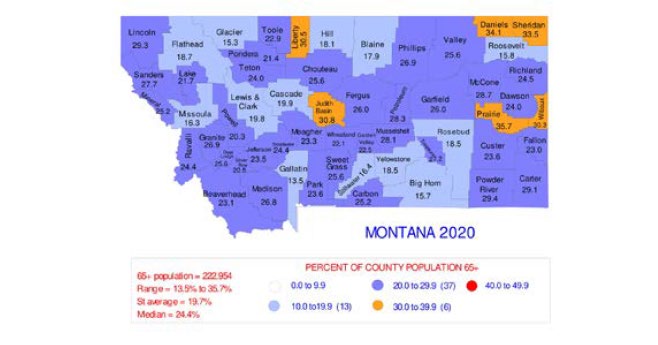
As the U.S. older adult population is expected to grow with aging baby boomers, opioid misuse among this group is becoming more urgent.
- Montana is one of the top 10 by percentage of population with the oldest population and expect to grow to the top 5 in 2030.
- As of 2018 estimates Montana is 6th in percentage of elder population.
- Many of Montana’s counties are already above the projected 25% of the population.
- Some counties are estimated above 30%.
- 25% of long term opioid users are aged 65+
- The population of older adults who misuse opioids is expected to double from 2004 to 2020
- 6 out of 1,000 Medicare beneficiaries (aged and disabled) are diagnosed with opioid use disorder one of the highest and fastest growing rates
- Women over 60 are more likely to use opioids than men
Montana 2030 Projections
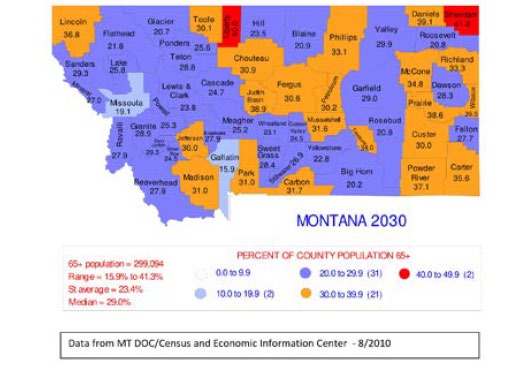
This is what the projection looks like in Montana
The Red indicates Counties at 40% or greater
The gold color represents counties with 30% of more
The dark blue represents those counties at 20-29%
And the light blue indicates those at 10-19%
"Grandfamilies"
An increasing number of opioid addicted adults, many of whom have children, are moving in with their older parents,
creating grand families. Parental substance misuse is the most common reason that an estimated 2.5 million children are being raised by grandparents and other relatives. Rural older adults are more likely than urban adults to be raising their grandchildren (8.9 vs.7.4%)
"Struggles of Grandfamilies"
- Many of these grandparents are impacted financially, legally, socially and physically.
- Some risk arrest, eviction or homelessness.
- Some purposefully or inadvertently increase the flow of drugs by selling their excess medications to supplement fixed incomes or by not closely tracking their medications which may be taken or sold by their addicted adult child.
- Many experience increased financial burden on fixed incomes
- Many struggle with depression and both physical and social isolation as well as physical demands of parenting grandchildren
Elder Abuse
We Don't Tolerate Abuse. If you see it, report it.
Many experts believe the opioid epidemic is associated with an increase in elder abuse including:
- Physical abuse including assault and battery, threatening behavior
- Emotional abuse
- Financial exploitation including theft, fraud and forgery
- Potential for homelessness due to arrest, eviction or illegal activity at the home
Rural Crisis
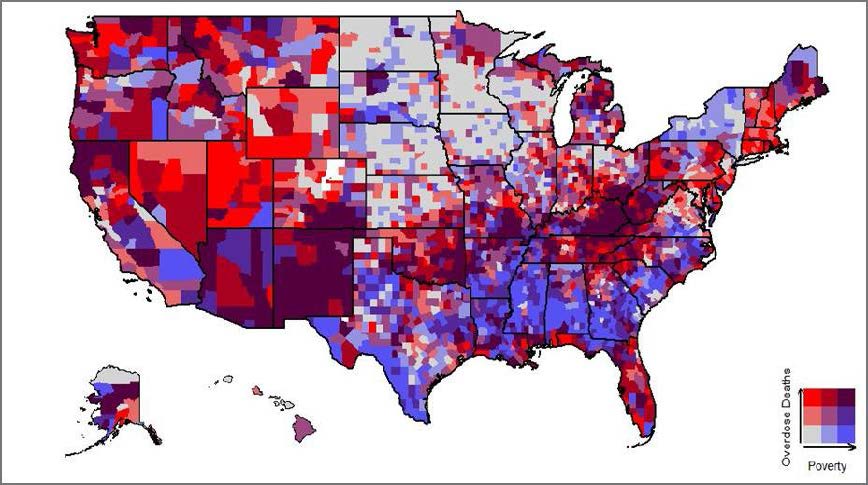
Perpetrators: Opioid addicted family members . . .
- Stealing medications for their own use or selling medications or other items of value belonging to the older adult for their own economic gain.
- Seeking refills on prescriptions, falsely claiming the older adult’s need for the medication.
- Using the older adult’s home as a place of illegal activity placing the elder at risk of arrest or losing the home.
- Using intimidation or engaging in physical violence against the elder.
The Problem Is Escalating In Scope And Severity
Research is showing us that opioids, outside of exploitation cases, have absolutely exacerbated the abuse/neglect of vulnerable adults. This is occurring not only by exploiting elders to receive money for opioids and stealing opioids, but by using opioids to sedate and neglect elders. Drugs open the possibility for more types of abuse because there are more individuals inside the home. Another threat and danger is when the money runs out, the victim does not have any resources to help with daily needs.
An Elder’s Home Becomes A Safety Hazard For Them
Homes become a marketing environment for drugs or people coming back and forth where they are taking drugs. [In] some situations, the older adult is involved with the drug abuse. One difficult situation is when the older adult has capacity and can make his/her own decisions, but the case managers and workers don’t realize what is going on because it is not reported by the elderly adult. Complaints of self neglect where bills are not getting paid, elders are missing appointments. Or the medical staff has an opioid addiction and takes medication out of the pack or off the cart in a facility for personal use and tells the older person they already received the medication and documents in the chart it was given. Praying on their lack of cognition and understanding.
Services Issues
Some of the services that the older adults accept; may allow the abuse to continue or enable the perpetrator to keep abusing. These services help the elders to solve their immediate problems of paying a utilities bill, but it allows the perpetrator to stay in the house. The tipping point is usually when the perpetrator gets in trouble and is no longer living in the home or when the elders lose capacity and allow workers to come into home. Most of the time, the perpetrator lives at the elder’s home or is coming into the household regularly to help with care.
Findings Of Research
Some findings on previous research regarding elder Abuse:
- Embedded within opioid related cases is evidence of polyvictimization
- Family physicians identified abuse as a result of a negative drug screening
- Older adults claimed to suffer no ill effects from their missing medication
- Perpetrators often had a history of criminal and substance abuse charges
- Older parents shielded their adult children from investigation, sometimes to their own detriment
Next Steps For Montanans
Research in Montana is continuing;
- Montana Adult Protective Services has obtained a grant from the Administration for Community Living to look at the issues in Montana and the Opioid use issue.
- Montana APS with key Montana Stakeholders will, over the next two-years, complete
a system transformation that builds on systems already in place.
- The objectives are:
(1)Document the problem and severity of opioid and substance misuse problems for both the alleged victim and the alleged perpetrator.
(2) Facilitate and document service delivery with a new service plan monitor team to document the substance misuse services referred and facilitate receipt of services for both the AV and the AP.
Contact or make a report to APS
or call, (844)-277-9300
Conference Day 2:
View Keeping Aging Adults Safe (Session 2) a presentation by Stacey Pascoe

